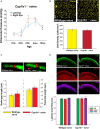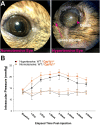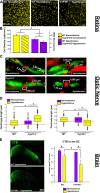Absence of Cytochrome P450-1b1 Increases Susceptibility of Pressure-Induced Axonopathy in the Murine Retinal Projection
- PMID: 33748124
- PMCID: PMC7973214
- DOI: 10.3389/fcell.2021.636321
Absence of Cytochrome P450-1b1 Increases Susceptibility of Pressure-Induced Axonopathy in the Murine Retinal Projection
Abstract
Mutations in the cytochrome P450-1B1 (Cyp1b1) gene is a common genetic predisposition associated with various human glaucomas, most prominently in primary congenital glaucoma (PCG). The role of Cyp1b1 in the eye is largely unknown, however, its absence appears to drive the maldevelopment of anterior eye structures responsible for aqueous fluid drainage in murine models. Nevertheless, vision loss in glaucoma ultimately results from the structural and functional loss of retinal ganglion cells (RGCs). Cyp1b1's influence in the development and support of retinal ganglion cell structure and function under normal conditions or during stress, such as elevated ocular pressure; the most common risk factor in glaucoma, remains grossly unknown. Thus, to determine the role of Cyp1b1 in normal retinal projection development we first assessed the strucutrual integrity of RGCs in the retina, optic nerve, and superior colliculus in un-manipulated (naïve) Cyp1b1-knockout (Cyp1b1-/-) mice. In addition, in a separate cohort of Cyp1b1-/- and wildtype mice, we elevated and maintained intraocular pressure (IOP) at glaucomatous levels for 5-weeks, after which we compared RGC density, node of Ranvier morphology, and axonal transport between the genotypes. Our results demonstrate that naïve Cyp1b1-/- mice develop an anatomically intact retinal projection absent of overt glaucomatous pathology. Following pressure elevation, Cyp1b1-/- accelerated degradation of axonal transport from the retina to the superior colliculus and altered morphology of the nodes of Ranvier and adjacent paranodes in the optic nerves. Together this data suggests the absence Cyp1b1 expression alone is insufficient to drive murine glaucomatous pathology, however, may increase the vulnerability of retinal axons to disease relevant elevations in IOP.
Keywords: axonal transport disruption; glaucoma; microbead occlusion model; nodes of Ranvier; retinal ganglion cell.
Copyright © 2021 Amirmokhtari, Foresi, Dewan, Bouhenni and Smith.
Conflict of interest statement
The authors declare that the research was conducted in the absence of any commercial or financial relationships that could be construed as a potential conflict of interest.
Figures



Similar articles
-
Interleukin-6 Deficiency Attenuates Retinal Ganglion Cell Axonopathy and Glaucoma-Related Vision Loss.Front Neurosci. 2017 May 31;11:318. doi: 10.3389/fnins.2017.00318. eCollection 2017. Front Neurosci. 2017. PMID: 28620279 Free PMC article.
-
Assessment of retinal ganglion cell damage in glaucomatous optic neuropathy: Axon transport, injury and soma loss.Exp Eye Res. 2015 Dec;141:111-24. doi: 10.1016/j.exer.2015.06.006. Epub 2015 Jun 9. Exp Eye Res. 2015. PMID: 26070986 Review.
-
Axon hyperexcitability in the contralateral projection following unilateral optic nerve crush in mice.Brain Commun. 2022 Oct 3;4(5):fcac251. doi: 10.1093/braincomms/fcac251. eCollection 2022. Brain Commun. 2022. PMID: 36267329 Free PMC article.
-
Absence of transient receptor potential vanilloid-1 accelerates stress-induced axonopathy in the optic projection.J Neurosci. 2014 Feb 26;34(9):3161-70. doi: 10.1523/JNEUROSCI.4089-13.2014. J Neurosci. 2014. PMID: 24573275 Free PMC article.
-
Cytochrome P450 1B1 and Primary Congenital Glaucoma.J Ophthalmic Vis Res. 2015 Jan-Mar;10(1):60-7. doi: 10.4103/2008-322X.156116. J Ophthalmic Vis Res. 2015. PMID: 26005555 Free PMC article. Review.
Cited by
-
Exploring the Genetic Landscape of Childhood Glaucoma.Children (Basel). 2024 Apr 9;11(4):454. doi: 10.3390/children11040454. Children (Basel). 2024. PMID: 38671671 Free PMC article. Review.
-
CYP1B1-derived epoxides modulate the TRPA1 channel in chronic pain.Acta Pharm Sin B. 2023 Jan;13(1):68-81. doi: 10.1016/j.apsb.2022.09.007. Epub 2022 Sep 14. Acta Pharm Sin B. 2023. PMID: 36815047 Free PMC article.
-
Markers of Hypoxia and Metabolism Correlate With Cell Differentiation in Retina and Lens Development.Front Ophthalmol (Lausanne). 2022 Apr 22;2:867326. doi: 10.3389/fopht.2022.867326. eCollection 2022. Front Ophthalmol (Lausanne). 2022. PMID: 38983523 Free PMC article.
-
Short-Term Omega-3 Supplementation Modulates Novel Neurovascular and Fatty Acid Metabolic Proteome Changes in the Retina and Ophthalmic Artery of Mice with Targeted Cyp2c44 Gene Deletion.Cells. 2022 Nov 4;11(21):3494. doi: 10.3390/cells11213494. Cells. 2022. PMID: 36359890 Free PMC article.
-
Insights into CYP1B1-Related Ocular Diseases Through Genetics and Animal Studies.Life (Basel). 2025 Mar 3;15(3):395. doi: 10.3390/life15030395. Life (Basel). 2025. PMID: 40141740 Free PMC article. Review.
References
-
- Akarsu A. N., Turacli M. E., Aktan S. G., Barsoum-Homsy M., Chevrette L., Sayli B. S., et al. (1996). A second locus (GLC3B) for primary congenital glaucoma (Buphthalmos) maps to the 1p36 region. Hum. Mol. Genet. 5 1199–1203. - PubMed
-
- Bansal S., Leu A. N., Gonzalez F. J., Guengerich F. P., Chowdhury A. R., Anandatheerthavarada H. K., et al. (2014). Mitochondrial targeting of cytochrome P450 (CYP) 1B1 and its role in polycyclic aromatic hydrocarbon-induced mitochondrial dysfunction. J. Biol. Chem. 289 9936–9951. 10.1074/jbc.M113.525659 - DOI - PMC - PubMed
LinkOut - more resources
Full Text Sources
Other Literature Sources
Molecular Biology Databases

